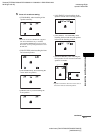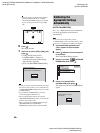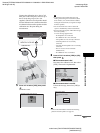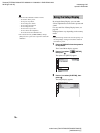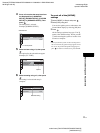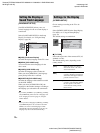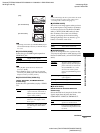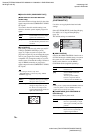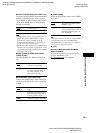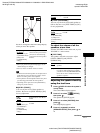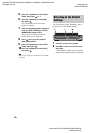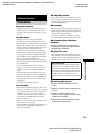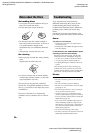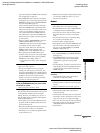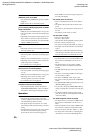
Advanced Settings and Adjustments
masterpage:Right
specdef v20061206
filename[E:\SS2007\Models\DC2\2895959111\2895959111DAVHDX265-266-
267W\gb11adv.fm]
model name [DAV-HDX265/HDX266/HDX267W]
[2-895-959-11(1)]
75
GB
x[TRACK SELECTION] (DVD VIDEO only)
Gives the sound track which contains the highest
number of channels priority when you play a
DVD VIDEO on which multiple audio formats
(PCM, DTS, MPEG audio, or Dolby Digital
format) are recorded.
Note
• When you set the item to [AUTO], the language may
change. The [TRACK SELECTION] setting has
higher priority than the [AUDIO] settings in
[LANGUAGE SETUP] (page 72). (Depending on
the disc, this function may not work.)
•If PCM, DTS, Dolby Digital sound, and MPEG audio
tracks have the same number of channels, the system
selects PCM, DTS, Dolby Digital sound, and MPEG
audio tracks in this order.
x[MULTI-DISC RESUME] (DVD VIDEO/
VIDEO CD only)
Switches the Multi-disc Resume setting on or
off.
x[AUDIO DRC] (DVD VIDEO only)
Narrows the dynamic range of the sound track.
Useful for watching movies at low volume late
at night.
x[AUDIO (HDMI)]
Selects the audio output status from the HDMI
OUT jack.
Note
• When you connect the unit and TV with the HDMI
cord and [ON] is selected, DYNAMIC BASS,
MOVIE/MUSIC, and sound field are not applied to
the sound that is output from the TV.
x[DivX]
(Except for United Kingdom and North
American models)
Displays the registration code for this system.
For more information, go to
http://www.divx.com on the Internet.
[OFF]
No priority given.
[AUTO]
Priority given.
[ON]
Stores the resume settings in
memory for up to 40 discs.
[OFF]
Does not store the resume settings
in memory. Playback restarts at
the resume point only for the
current disc in the unit.
[OFF]
No compression of dynamic
range.
[STANDARD]
Reproduces the sound track with
the kind of dynamic range that the
recording engineer intended.
[MAX]
Compresses dynamic range fully.
[OFF]
The sound is not output from the
HDMI OUT jack.
[ON]
Outputs audio signals by
converting Dolby Digital, DTS, or
96 kHz/24 bit PCM signals to 48
kHz/ 16 bit PCM.



